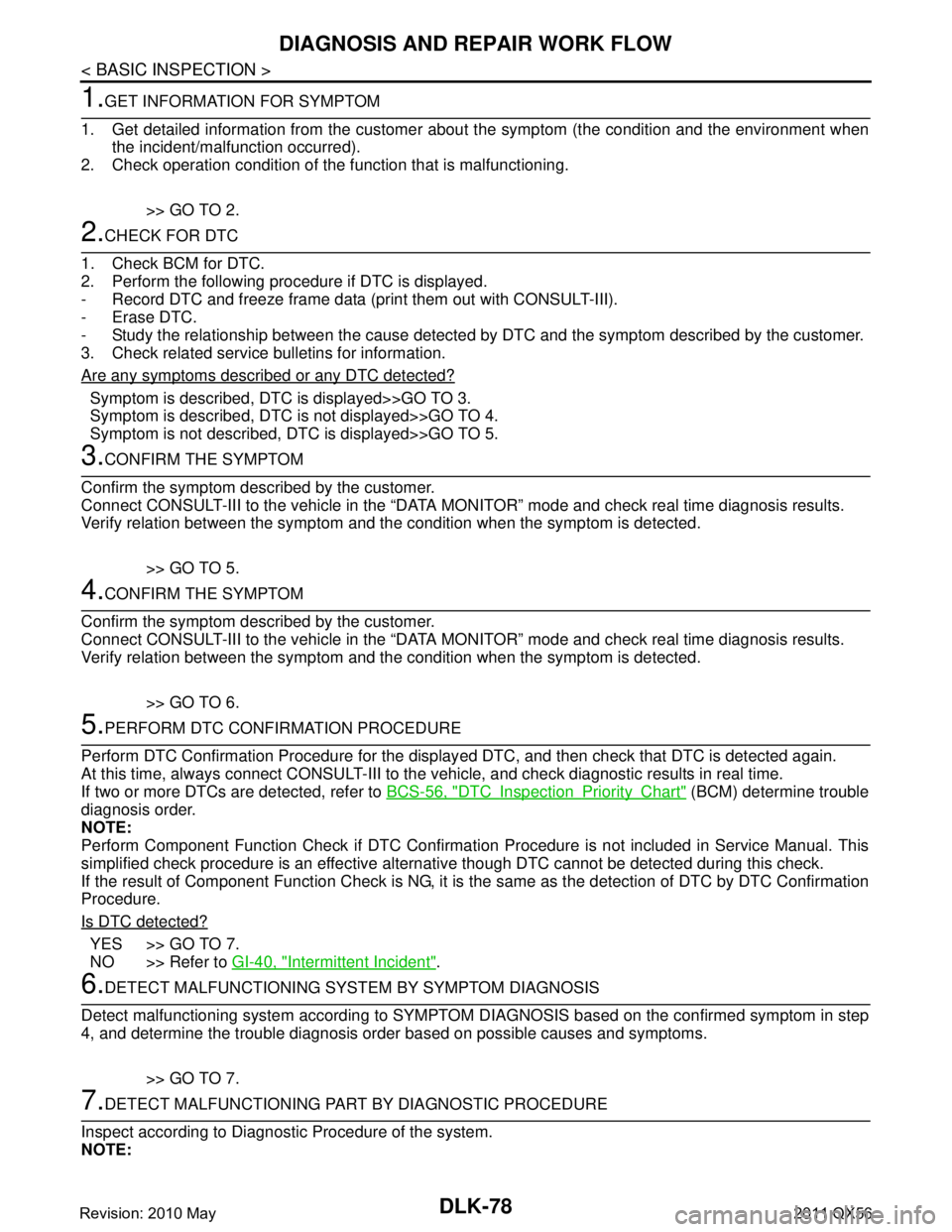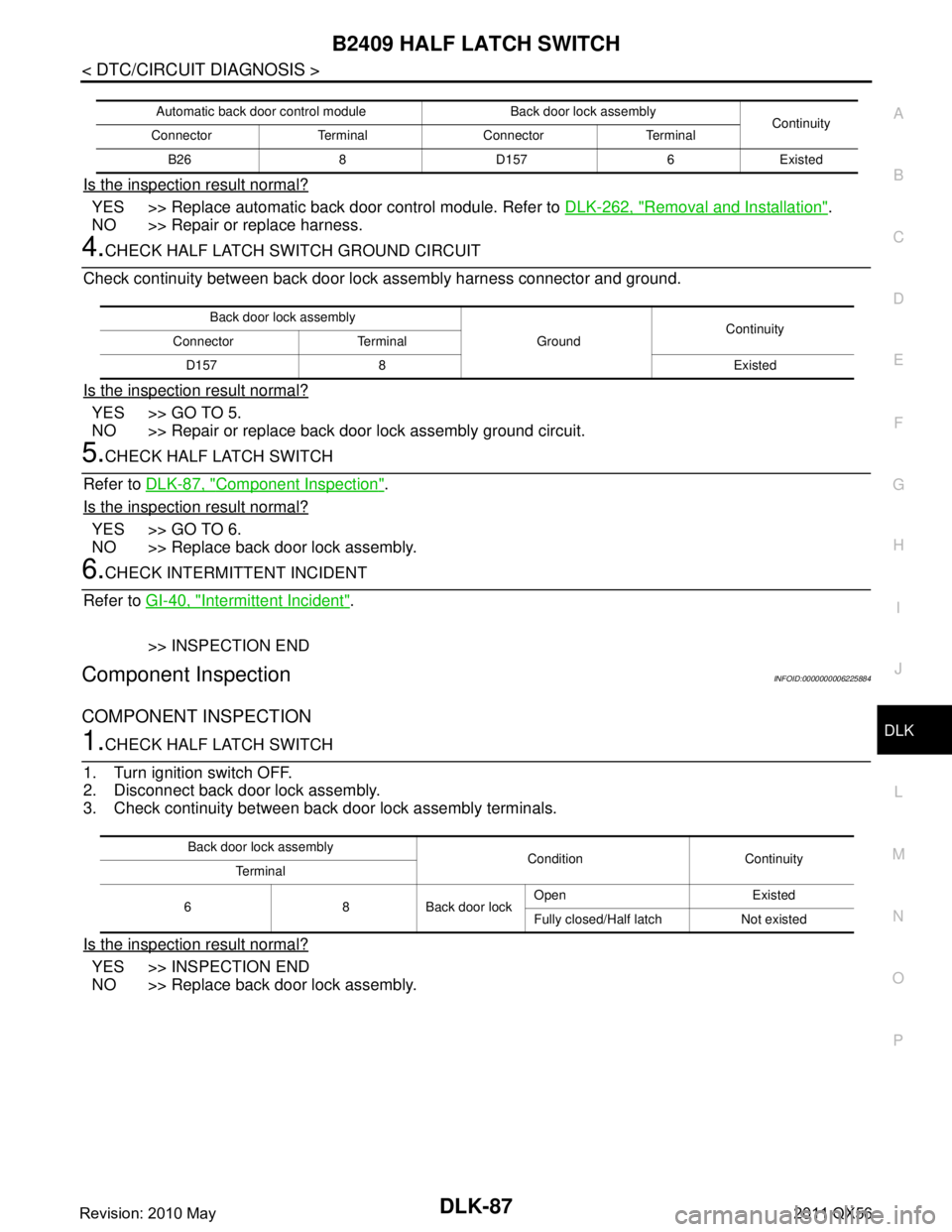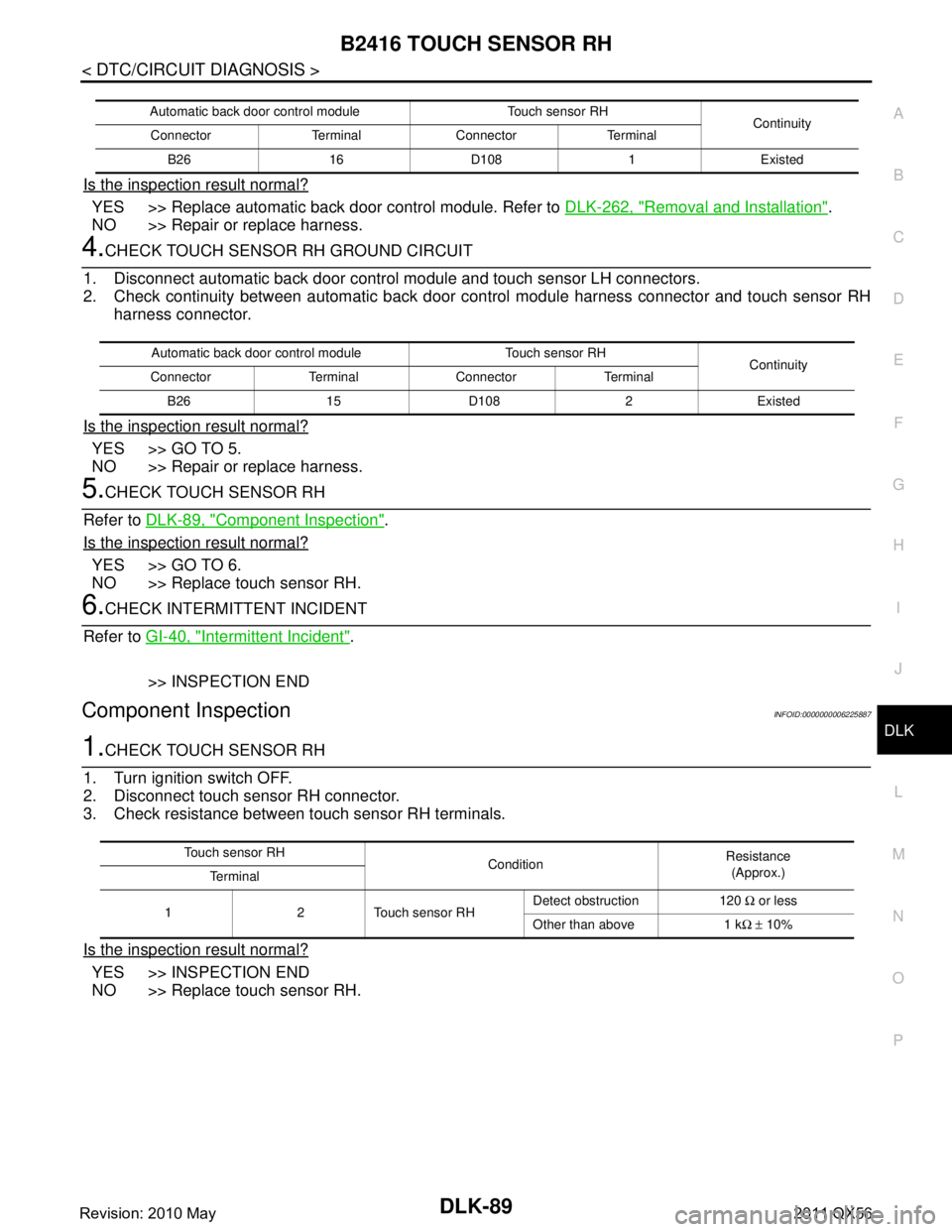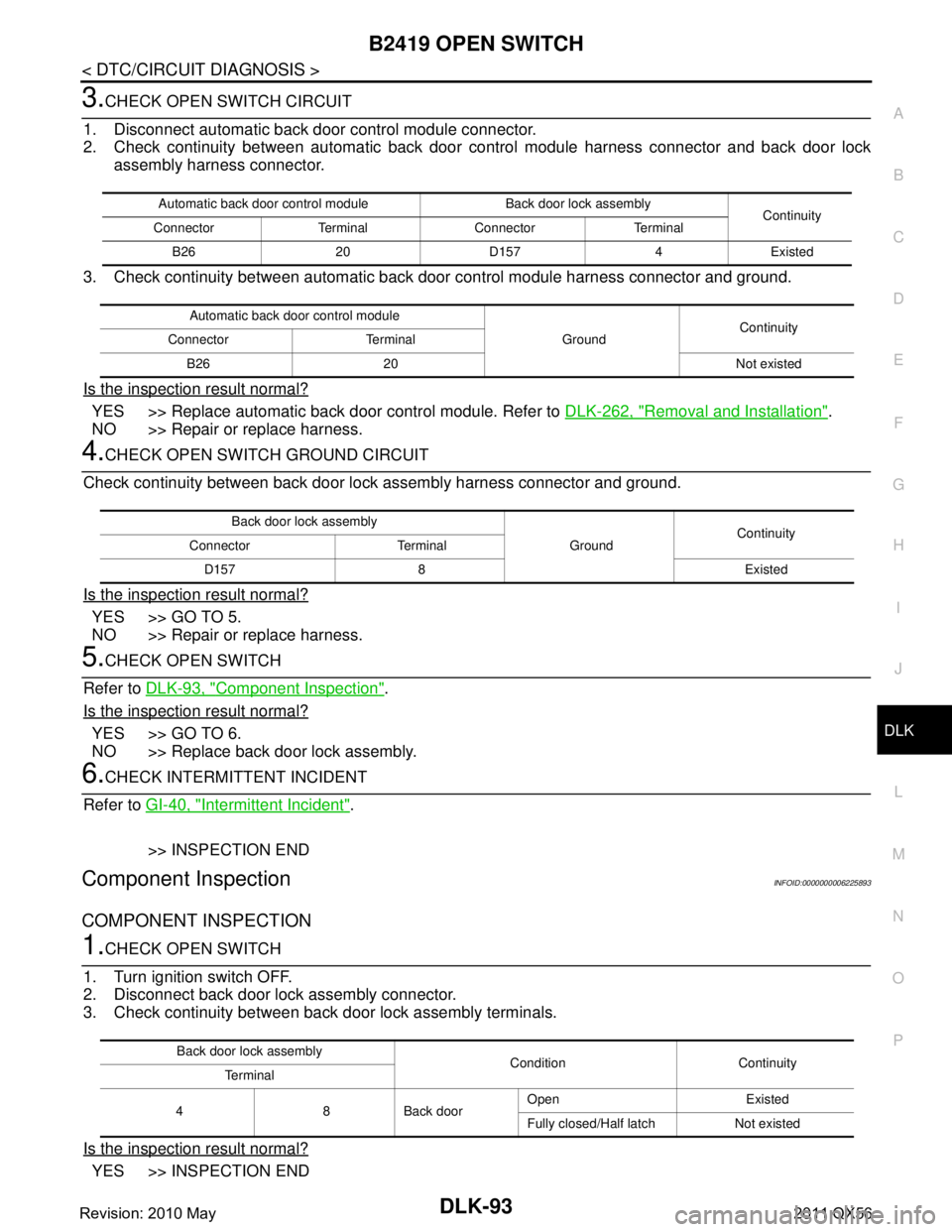2011 INFINITI QX56 air condition
[x] Cancel search: air conditionPage 1574 of 5598

DLK-38
< SYSTEM DESCRIPTION >
DIAGNOSIS SYSTEM (BCM)
DIAGNOSIS SYSTEM (BCM)
COMMON ITEM
COMMON ITEM : CONSULT-III Function (BCM - COMMON ITEM)INFOID:0000000006307583
APPLICATION ITEM
CONSULT-III performs the following functions via CAN communication with BCM.
SYSTEM APPLICATION
BCM can perform the following functions for each system.
NOTE:
It can perform the diagnosis modes except the following for all sub system selection items.
×: Applicable item
*: This item is indicated, but not used.
FREEZE FRAME DATA (FFD)
The BCM records the following vehicle condition at the time a particular DTC is detected, and displays on
CONSULT-III.
Diagnosis mode Function Description
Work Support Changes the setting for each system function.
Self Diagnostic Result Displays the diagnosis results judged by BCM. Refer to BCS-57, "
DTCIndex".
CAN Diag Support Monitor Monitors the reception status of CAN communication viewed from BCM. Refer to CONSULT-III opera-
tion manual.
Data Monitor The BCM input/output signals are displayed.
Active Test The signals used to activate ea ch device are forcibly supplied from BCM.
Ecu Identification The BCM part number is displayed.
Configuration Read and save the vehicle specification.
Write the vehicle specification when replacing BCM.
System Sub system selection item Diagnosis mode
Work Support Data Monitor Active Test
Door lock DOOR LOCK ×××
Rear window defogger REAR DEFOGGER ××
Warning chime BUZZER ××
Interior room lamp timer INT LAMP ×××
Exterior lamp HEAD LAMP ×××
Wiper and washer WIPER ×××
Turn signal and hazard warning lamps FLASHER ×××
— AIR CONDITONER* ××
Intelligent Key system
Engine start system INTELLIGENT KEY
×××
Combination switch COMB SW ×
Body control system BCM ×
IVIS IMMU ×××
Interior room lamp battery saver BATTERY SAVER ×××
Back door TRUNK ×
Vehicle security system THEFT ALM ×××
RAP system RETAINED PWR ×
Signal buffer system SIGNAL BUFFER ××
Revision: 2010 May2011 QX56
Page 1614 of 5598

DLK-78
< BASIC INSPECTION >
DIAGNOSIS AND REPAIR WORK FLOW
1.GET INFORMATION FOR SYMPTOM
1. Get detailed information from the customer about the symptom (the condition and the environment when
the incident/malfunction occurred).
2. Check operation condition of the function that is malfunctioning.
>> GO TO 2.
2.CHECK FOR DTC
1. Check BCM for DTC.
2. Perform the following procedure if DTC is displayed.
- Record DTC and freeze frame data (print them out with CONSULT-III).
- Erase DTC.
- Study the relationship between the cause detected by DTC and the symptom described by the customer.
3. Check related service bulletins for information.
Are any symptoms described or any DTC detected?
Symptom is described, DTC is displayed>>GO TO 3.
Symptom is described, DTC is not displayed>>GO TO 4.
Symptom is not described, DTC is displayed>>GO TO 5.
3.CONFIRM THE SYMPTOM
Confirm the symptom described by the customer.
Connect CONSULT-III to the vehicle in the “DATA MO NITOR” mode and check real time diagnosis results.
Verify relation between the symptom and the condition when the symptom is detected.
>> GO TO 5.
4.CONFIRM THE SYMPTOM
Confirm the symptom described by the customer.
Connect CONSULT-III to the vehicle in the “DATA MO NITOR” mode and check real time diagnosis results.
Verify relation between the symptom and the condition when the symptom is detected.
>> GO TO 6.
5.PERFORM DTC CONFIRMATION PROCEDURE
Perform DTC Confirmation Procedure for the display ed DTC, and then check that DTC is detected again.
At this time, always connect CONSULT-III to the vehicle, and check diagnostic results in real time.
If two or more DTCs are detected, refer to BCS-56, "
DTCInspectionPriorityChart" (BCM) determine trouble
diagnosis order.
NOTE:
Perform Component Function Check if DTC Confirmati on Procedure is not included in Service Manual. This
simplified check procedure is an effective alternat ive though DTC cannot be detected during this check.
If the result of Component Function Check is NG, it is the same as the detection of DTC by DTC Confirmation
Procedure.
Is DTC detected?
YES >> GO TO 7.
NO >> Refer to GI-40, "
Intermittent Incident".
6.DETECT MALFUNCTIONING SYSTEM BY SYMPTOM DIAGNOSIS
Detect malfunctioning system according to SYMPTOM DIAGNOSIS based on the confirmed symptom in step
4, and determine the trouble diagnosis order based on possible causes and symptoms.
>> GO TO 7.
7.DETECT MALFUNCTIONING PART BY DIAGNOSTIC PROCEDURE
Inspect according to Diagnostic Procedure of the system.
NOTE:
Revision: 2010 May2011 QX56
Page 1620 of 5598

DLK-84
< DTC/CIRCUIT DIAGNOSIS >
B2401 IGNITION POWER SUPPLY CIRCUIT
B2401 IGNITION POWER SUPPLY CIRCUIT
DTC LogicINFOID:0000000006225878
DTC DETECTION LOGIC
DTC CONFIRMATION PROCEDURE
1.PERFORM DTC CONFIRMATION PROCEDURE
1. Turn ignition switch ON and wait for at least 1 second.
2. Check “Self Diagnostic Result” mode of “AUTOMAT IC BACK DOOR CONTROL UNIT” using CONSULT-
III.
Is DTC detected?
YES >> Refer to DLK-84, "Diagnosis Procedure".
NO >> INSPECTION END
Diagnosis ProcedureINFOID:0000000006225879
1.CHECK FUSE
1. Turn ignition switch OFF.
2. Check 10A fuse, [No. 4, located in fuse block (J/B)].
Is the inspection result normal?
YES >> GO TO 2.
NO >> Replace the blown fuse after repairing the affected circuit if a fuse is blown.
2.CHECK POWER SUPPLY CIRCUIT
1. Turn ignition switch OFF.
2. Disconnect automatic back door control unit connector.
3. Check voltage between automatic back door control unit harness connector and ground.
Is the measurement value normal?
YES >> Check intermittent incident. Refer to GI-40, "Intermittent Incident".
NO >> Repair or replace harness.
DTC CONSULT-III display
description DTC detecting condition Possible cause
B2401 IGN OPEN When the automatic back door control unit detects
the following condition for 0.3 second or more
Power supply condition (OFF) of automatic back
door control unit and Ignition position signal (ON)
from BCM via CAN Fuse
Harness or connectors
(Ignition power supply condition
circuit is open or shorted)
(+)
(− ) Condition Vo l ta g e
(Approx.)
Automatic back door control unit
Connector Terminal
B26 9 Ground Ignition switch ON Battery voltage
OFF 0 V
Revision: 2010 May2011 QX56
Page 1621 of 5598

B2403 ENCODERDLK-85
< DTC/CIRCUIT DIAGNOSIS >
C
DE
F
G H
I
J
L
M A
B
DLK
N
O P
B2403 ENCODER
DTC LogicINFOID:0000000006225880
DTC DETECTION LOGIC
DTC CONFIRMATION PROCEDURE
1.PERFORM DTC CONFIRMATION PROCEDURE
1. Turn ignition switch ON.
2. Check “Self Diagnostic Result” mode of “AUTOMAT IC BACK DOOR CONTROL UNIT” using CONSULT-
III.
Is DTC detected?
YES >> Refer to DLK-85, "Diagnosis Procedure".
NO >> INSPECTION END
Diagnosis ProcedureINFOID:0000000006225881
1.CHECK AUTOMATIC BACK DOOR CONTROL MODULE POWER SUPPLY AND GROUND CIRCUIT
1. Turn ignition switch OFF.
2. Check automatic back door control module power supply and ground circuit. Refer to DLK-116, "
AUTOMATIC BACK DOOR CONTROL UNIT : Diagnosis Procedure".
Is the inspection result normal?
YES >> Replace automatic back door control module. Refer to DLK-262, "Removal and Installation".
NO >> Repair or replace the malfunctioning parts.
DTC CONSULT-III dis-
play description DTC detecting condition Possible cause
B2403 PULSE ENCODER When the automatic back door control unit can not re-
ceive the signal from the encoder just after starting the
open/close operation Battery voltage (low battery)
Automatic back door control mod-
ule
Revision: 2010 May2011 QX56
Page 1623 of 5598

B2409 HALF LATCH SWITCHDLK-87
< DTC/CIRCUIT DIAGNOSIS >
C
DE
F
G H
I
J
L
M A
B
DLK
N
O P
Is the inspection result normal?
YES >> Replace automatic back door control module. Refer to DLK-262, "Removal and Installation".
NO >> Repair or replace harness.
4.CHECK HALF LATCH SWITCH GROUND CIRCUIT
Check continuity between back door lo ck assembly harness connector and ground.
Is the inspection result normal?
YES >> GO TO 5.
NO >> Repair or replace back door lock assembly ground circuit.
5.CHECK HALF LATCH SWITCH
Refer to DLK-87, "
Component Inspection".
Is the inspection result normal?
YES >> GO TO 6.
NO >> Replace back door lock assembly.
6.CHECK INTERMITTENT INCIDENT
Refer to GI-40, "
Intermittent Incident".
>> INSPECTION END
Component InspectionINFOID:0000000006225884
COMPONENT INSPECTION
1.CHECK HALF LATCH SWITCH
1. Turn ignition switch OFF.
2. Disconnect back door lock assembly.
3. Check continuity between back door lock assembly terminals.
Is the inspection result normal?
YES >> INSPECTION END
NO >> Replace back door lock assembly.
Automatic back door control module Back door lock assembly Continuity
Connector Terminal Connector Terminal
B26 8 D157 6 Existed
Back door lock assembly GroundContinuity
Connector Terminal
D157 8 Existed
Back door lock assembly Condition Continuity
Te r m i n a l
6 8 Back door lock Open Existed
Fully closed/Half latch Not existed
Revision: 2010 May2011 QX56
Page 1625 of 5598

B2416 TOUCH SENSOR RHDLK-89
< DTC/CIRCUIT DIAGNOSIS >
C
DE
F
G H
I
J
L
M A
B
DLK
N
O P
Is the inspection result normal?
YES >> Replace automatic back door control module. Refer to DLK-262, "Removal and Installation".
NO >> Repair or replace harness.
4.CHECK TOUCH SENSOR RH GROUND CIRCUIT
1. Disconnect automatic back door control module and touch sensor LH connectors.
2. Check continuity between automatic back door c ontrol module harness connector and touch sensor RH
harness connector.
Is the inspection result normal?
YES >> GO TO 5.
NO >> Repair or replace harness.
5.CHECK TOUCH SENSOR RH
Refer to DLK-89, "
Component Inspection".
Is the inspection result normal?
YES >> GO TO 6.
NO >> Replace touch sensor RH.
6.CHECK INTERMITTENT INCIDENT
Refer to GI-40, "
Intermittent Incident".
>> INSPECTION END
Component InspectionINFOID:0000000006225887
1.CHECK TOUCH SENSOR RH
1. Turn ignition switch OFF.
2. Disconnect touch sensor RH connector.
3. Check resistance between touch sensor RH terminals.
Is the inspection result normal?
YES >> INSPECTION END
NO >> Replace touch sensor RH.
Automatic back door control module Touch sensor RH Continuity
Connector Terminal Connector Terminal
B26 16 D108 1 Existed
Automatic back door control module Touch sensor RH Continuity
Connector Terminal Connector Terminal
B26 15 D108 2 Existed
Touch sensor RH ConditionResistance
(Approx.)
Te r m i n a l
1 2 Touch sensor RH Detect obstruction 120
Ω or less
Other than above 1 k Ω ± 10%
Revision: 2010 May2011 QX56
Page 1627 of 5598

B2417 TOUCH SENSOR LHDLK-91
< DTC/CIRCUIT DIAGNOSIS >
C
DE
F
G H
I
J
L
M A
B
DLK
N
O P
Is the inspection result normal?
YES >> Replace automatic back door control module. Refer to DLK-262, "Removal and Installation".
NO >> Repair or replace harness.
4.CHECK TOUCH SENSOR LH GROUND CIRCUIT
1. Disconnect automatic back door control module and touch sensor RH connectors.
2. Check continuity between automatic back door c ontrol module harness connector and touch sensor LH
harness connector.
Is the inspection result normal?
YES >> GO TO 5.
NO >> Repair or replace harness.
5.CHECK TOUCH SENSOR LH
Refer to DLK-91, "
Component Inspection".
Is the inspection result normal?
YES >> GO TO 6.
NO >> Replace touch sensor LH.
6.CHECK INTERMITTENT INCIDENT
Refer to GI-40, "
Intermittent Incident".
>> INSPECTION END
Component InspectionINFOID:0000000006225890
1.CHECK TOUCH SENSOR LH
1. Turn ignition switch OFF.
2. Disconnect touch sensor LH connector.
3. Check resistance between touch sensor LH terminals.
Is the inspection result normal?
YES >> INSPECTION END
NO >> Replace touch sensor LH.
Automatic back door control module Touch sensor LH Continuity
Connector Terminal Connector Terminal
B26 14 D107 1 Existed
Automatic back door control module Touch sensor LH Continuity
Connector Terminal Connector Terminal
B26 15 D107 2 Existed
Touch sensor LH ConditionResistance
(Approx.)
Te r m i n a l
1 2 Touch sensor LH Detect obstruction 120
Ω or less
Other than above 1 k Ω ± 10%
Revision: 2010 May2011 QX56
Page 1629 of 5598

B2419 OPEN SWITCHDLK-93
< DTC/CIRCUIT DIAGNOSIS >
C
DE
F
G H
I
J
L
M A
B
DLK
N
O P
3.CHECK OPEN SWITCH CIRCUIT
1. Disconnect automatic back door control module connector.
2. Check continuity between automatic back door control module harness connector and back door lock
assembly harness connector.
3. Check continuity between automatic back door control module harness connector and ground.
Is the inspection result normal?
YES >> Replace automatic back door control module. Refer to DLK-262, "Removal and Installation".
NO >> Repair or replace harness.
4.CHECK OPEN SWITCH GROUND CIRCUIT
Check continuity between back door lo ck assembly harness connector and ground.
Is the inspection result normal?
YES >> GO TO 5.
NO >> Repair or replace harness.
5.CHECK OPEN SWITCH
Refer to DLK-93, "
Component Inspection".
Is the inspection result normal?
YES >> GO TO 6.
NO >> Replace back door lock assembly.
6.CHECK INTERMITTENT INCIDENT
Refer to GI-40, "
Intermittent Incident".
>> INSPECTION END
Component InspectionINFOID:0000000006225893
COMPONENT INSPECTION
1.CHECK OPEN SWITCH
1. Turn ignition switch OFF.
2. Disconnect back door lock assembly connector.
3. Check continuity between back door lock assembly terminals.
Is the inspection result normal?
YES >> INSPECTION END
Automatic back door control module Back door lock assembly Continuity
Connector Terminal Connector Terminal
B26 20 D157 4 Existed
Automatic back door control module GroundContinuity
Connector Terminal
B26 20 Not existed
Back door lock assembly GroundContinuity
Connector Terminal
D157 8 Existed
Back door lock assembly Condition Continuity
Te r m i n a l
4 8 Back door Open Existed
Fully closed/Half latch Not existed
Revision: 2010 May2011 QX56